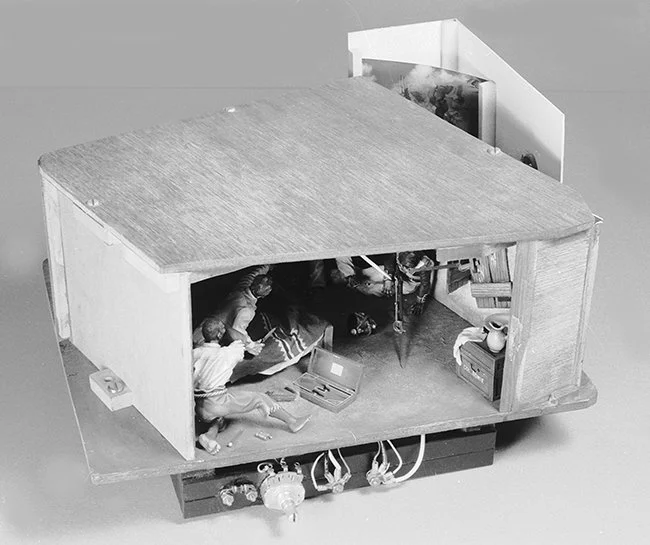From Sheperd Paine: The Life and Work of a Master Military Modeler and Historian by Jim DeRogatis (Schiffer Books, 2008)
J.D. Moving on to “The Death of Jim Bowie,” I’ve got to ask if this came before or after the Alamo scene you sculpted for the Franklin Mint?
S.P. “The Death of Jim Bowie” was done before the Franklin Mint piece, which wasn’t done until 1985, for release in 1986, on the one hundred-fiftieth anniversary of the battle. The attraction here was a good, enclosed scene with interesting lighting effects: the dawn light coming through the doorway and the window, and the explosion of the firing pistol, which I’d never done before. I think the other thing I liked was the slingshot action of the composition: the backwards recoil of the slave, balanced by the strong counter-motion of Bowie leaning forward, culminating with the explosion of the pistol, right in the middle of the picture. I also liked the Mexican soldier who was hit being thrown back against the door, and the others tumbling forward into the room behind him.
J.D. There’s an incredible amount of movement in the box, given the fact that the central figure is bedridden. How did you do the explosion of the pistol?
S.P. The explosion is done with fiberglass insulation—the pink stuff that goes up in the attic. There’s an orange grain-of-wheat bulb in the center, and the fiberglass transmits that color into a fuzzy orange fireball. If you look closely, you can actually see the flash in the priming pan of the pistol: There’s a micro-mini bulb coming through the back of the pistol.
J.D. The Alamo is hard to model, because it was such an epic battle, but you found a perfect moment to capture the drama of it all.
S.P. Of course, as you are aware, nobody really knows how Jim Bowie died. But Joe Musso spent a lifetime studying Bowie, and he was of the opinion that if Bowie was conscious, he’d have gone down fighting—that’s the kind of man he was. If he was unconscious, they’d have killed him in his bed without resistance, but that wouldn’t have been a very dramatic box.
J.D. How extensive were the sketches you’d do for these boxes?
S.P. Not very. I sometimes did a rough sketch while I was working out the overall composition, and as I said, I drew up detailed plans for complex interiors like the Victory and the Monitor. Otherwise, I tended to make things up as I went along. I had a soft-focus image in my mind of the overall group, but the individual figures usually didn’t come into focus until I started working on them. I’d usually start with one of the central figures, and from there, the posing of one would come from the pose of another.
Jim DeRogatis purchased “The Death of Jim Bowie” from Jeff Anderson in the late summer of 2023; Jeff is the grandson of Shep’s friend Bill Pritchard and has overseen the estate since Bill’s death. Bill was previously the only owner of the box. The Alamo always held a special fascination for Jim—in third grade at Catholic school in New Jersey, when everyone had to find a pen pal from another state, he struck up a friendship with a Mexican girl in San Antonio who’d send postcards and photos of the site at his request. Jim updated the box with new LED lighting and a safer transformer as he’d done with the boxes secured at auction several months earlier. Here is a look at that work.
Flying home with the box from New England. (It got its own seat on the plane.)
The box in its new home. The lighting was still working, but it needing updating to secure its life for decades to come.
The inner tray removed from the box. As with the other boxes I restored, the heavy corrosion on the potentiometers and wire couplings very much meant they needed to be replaced.
The inner scene exposed, with the roof and walls of the long barracks removed.
A Shep “Easter egg”: The lizard climbing the left wall, barely visible in the finished diorama, but we know it’s there!
A look at the LEDs installed outside the window and door to replicate the dawn light streaming in. They are secured with Velcro for easy removal if any need to be replaced in the distant future.
A new power switch replaced the old one, which was corroded, and dimmers were added for the sunlight, the cheater spot on the reveal, the candle, and the gun blast and muzzle flash. (Micro-mini LED chips replaced the original micro-bulbs Shep used, but the pink insulation he’d pinched from his basement was still intact to mask the flash!)
The restored box. Also see Bob Sarnowski’s photos from the special Shep Exhibit at the MMSI’s 2023 Chicago Show.











